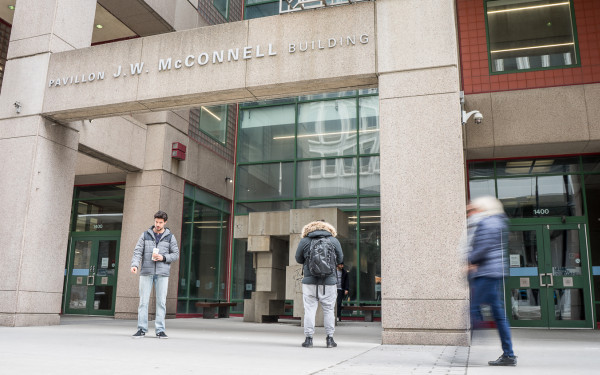Concordia Administration Dismissive of Older Buildings in Need of Renovations
The University’s Annexes Prove to be Inaccessible
Concordia is a giant web of infrastructure looming over Montreal.
Its campuses consist of 58 buildings, spread throughout Notre-Dame-de-Grace and downtown.
Sixty-three per cent of those buildings, according to Radio-Canada, are in a state of disrepair.
The number comes out of a report, commissioned by the provincial government and the province’s universities, which Radio-Canada obtained.
The report, which surfaced on Oct. 5, explains that more than 40 per cent of all Quebec university buildings received a grade of D or E—classifying them as being either in a high or very high state of disrepair. Concordia holds the third spot on the list, just behind McGill and Université de Montreal.
“I don’t think poor state is the right term,” said Chris Mota, Concordia University’s spokesperson, specifying that “requires renovation” would be more accurate. Mota explained that the report, which was put together by an external consultant, used each university’s separate civic address to compile the numbers. She said the results don’t accurately portray Concordia’s infrastructure reality.
“It sounds like the situation is bigger than it really is,” said Mota. Specifically, she explained that it’s Concordia’s annex buildings—those older triplex and quadruplex-like homes turned offices along Mackay St. and Bishop St., for examples—that skew the numbers. “When you look at square footage and the footprint of the university, those annexes represent very little, in the scheme of things,” Mota added.
During a Concordia Senate meeting on Oct. 7, Concordia president Alan Shepard echoed the same idea. “If you’re in the annexes, you might agree,” he said of the report.
Despite not amassing the same square-footage as the more frequented EV, Hall and MB buildings downtown for example, they house more than 20 university departments and Concordia services, such as the Graduate Student Association and the department of Philosophy.
The state of these buildings create a reality in which inaccessibility is the status quo, said Julie Michaud, administrative coordinator of the Centre for Gender Advocacy, whose office is located on the ground level of Annex V, on Mackay St.
“Certainly some of the annexes aren’t step free, like ours is,” said Michaud. “Of course any of the organizations on the floors above us are not accessible.”
The Centre for Gender Advocacy recently completed an accessibility audit for their annex after having been “called out a little bit for hosting an event in a place that had stairs, and that had no option for getting in, apart from those stairs,” she explained. “I think that was really legitimate for people to call us out on that.”
“I think, always, the goal of accessibility is [to become] the norm for everyone.” – Julie Michaud, administrative coordinator, Centre for Gender Advocacy.
Michaud said the results of the audit, which were presented to the Centre’s board last week, would be released shortly. What was most predominant was the required change in thinking. “I think accessibility is always the last thing on the list, and that needs to be shifted,” she explained.
When it comes to their office space, Michaud offered the example of their front door. While it sits atop a ramp, it is heavy and not automated. They’re planning on adding on a doorbell as a band-aid fix, although it does not address the issue head on.
“I think, always, the goal of accessibility is [to become] the norm for everyone,” elaborated Michaud. “It’s not like a person with a disability has to make a special request for you to let them into the building.” In this situation, the doorbell acts as a special request.
Replacing the front door, however, would be a costly expense—one the university told the Centre years ago would be their financial responsibility, according to Michaud.
When asked about renovation priorities, Mota explained that a team of engineers develop a plan internally with Concordia Facilities Management.
Number one, said Mota, is safety. “It is our absolute priority.”
Other than that, Mota explained in an email that renovation plans are dependent on a number of variables, and therefore could not be shared.
“I do think there needs to be a plan to get everything at Concordia accessible, and not decades down the road, but soon,” said Michaud on what she would like to see for Concordia’s renovation priorities. “There are a lot of really wonderful services in the annexes and I think too often disabled people are just told to be patient.”
The Centre, a Concordia-based organization, is “mandated to promote gender equality and empowerment particularly as it relates to marginalized communities.” Part of its mission includes, “providing an accessible space to facilitate community organizing and action,” something which is impeded by the state of the annexes.
Among the services located in Concordia’s annexes is also Concordia’s Simone de Beauvoir Institute. They describe themselves as having “the oldest Women’s Studies program in Canada and is recognized as one of the most innovative places in Quebec and Canada to study feminisms and develop initiatives that promote equality and social justice for all.” It also sits beyond a small flight of stairs, without a ramp.
After reviewing the results of their audit, Michaud said the Centre is looking towards creating a permanent accessibility coordinator position to assure that accessibility rides to the top of their list of priorities.
“We’re there reminding the university that in all of its operations that [accessibility] has to be an integral part of every consideration,” Michaud said.

web_900_600_90.jpg)
_600_832_s.png)

_600_375_90_s_c1.jpg)


_600_375_s_c1.png)